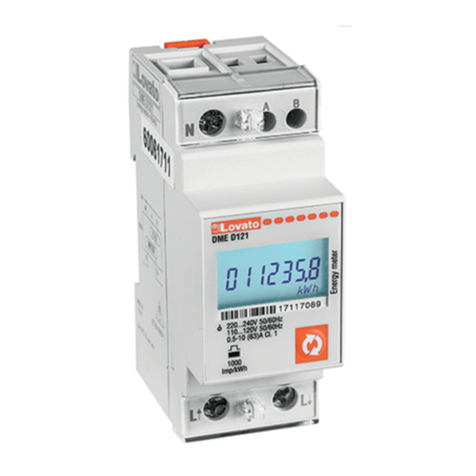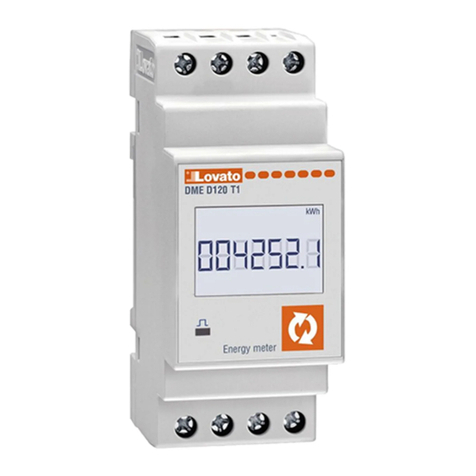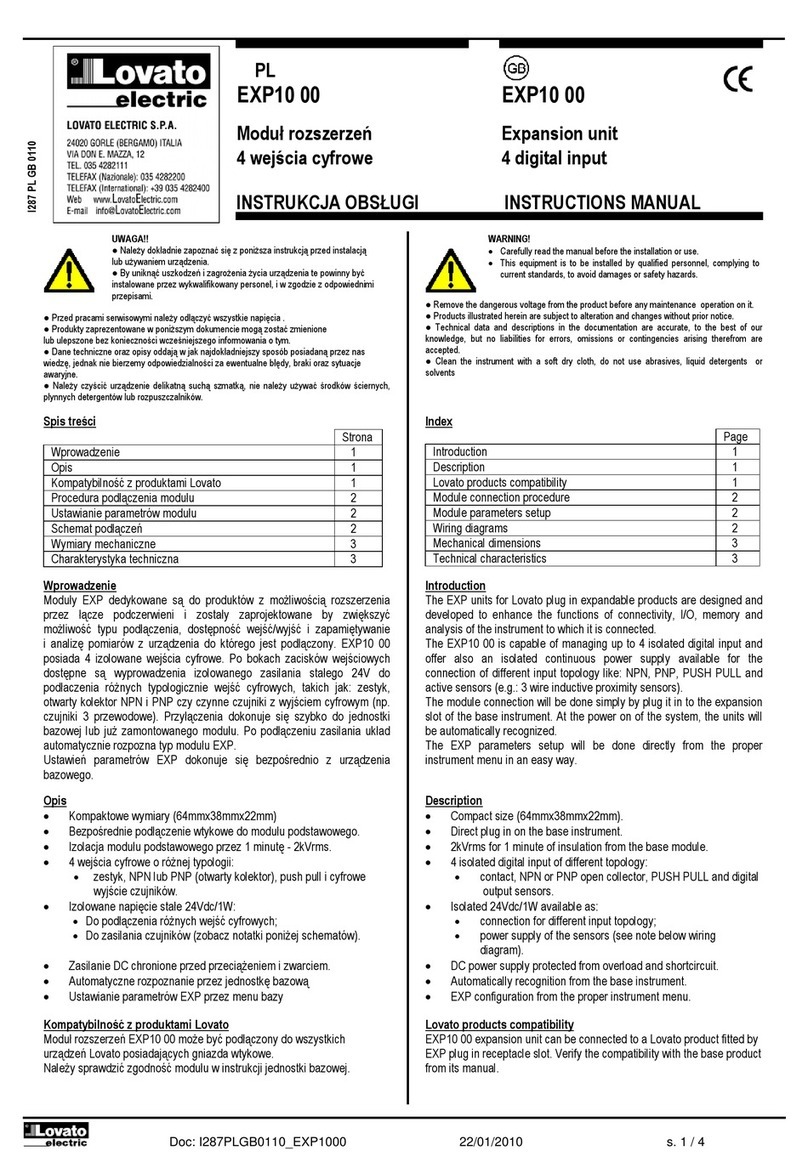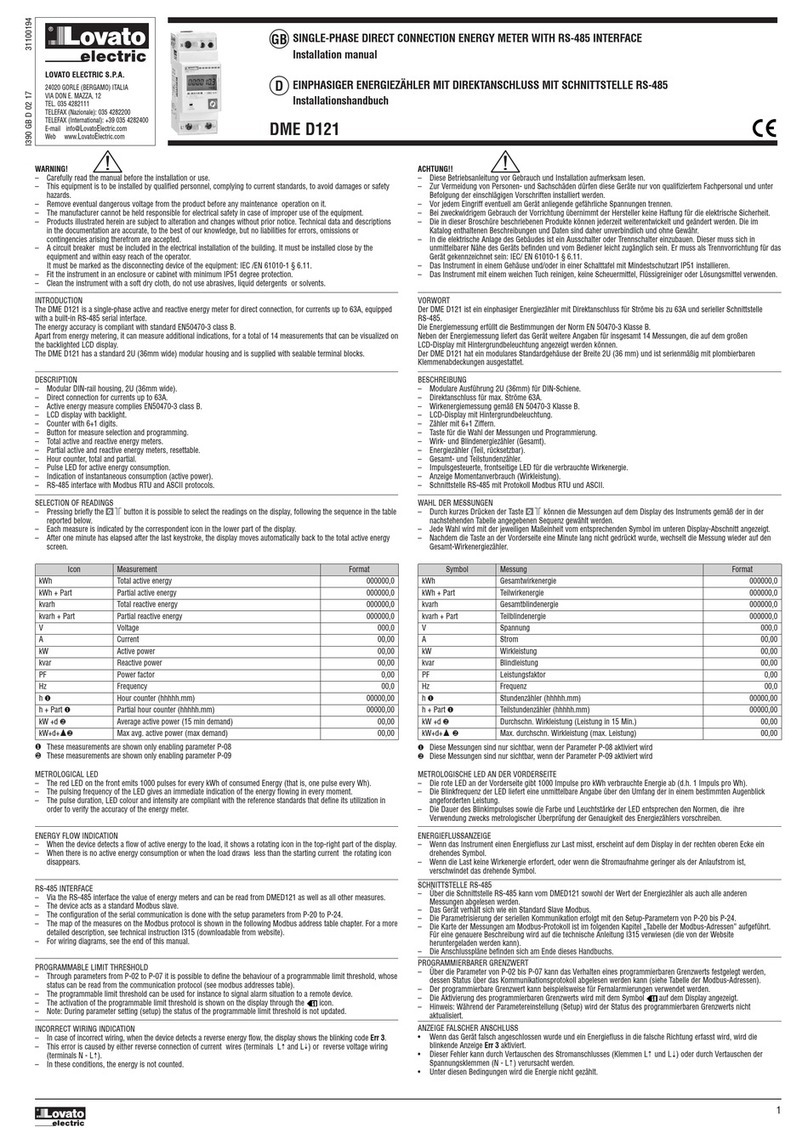
Doc: I306PLGB0411 20/04/2011 s. 3 / 7
Te pomiary wyświetlane s
tylko przy włączonym parametrze P5-01.
Te pomiary wyświetlane sątylko przy włączonym parametrze P5-02.
These measurements are shown only enabling parameter P5-01.
These measurements are shown only enabling parameter P5-02.
Metrologiczna dioda LED
Czerwona dioda LED, znajdująca sięna panelu przednim, emituje 1000
impulsów na każdąkWh pobranej energii (to jest 1 impuls na każdąWh).
Częstotliwość pulsowania diody LED wskazuje chwilowy przepływ energii
w każdym momencie.
Czas trwania impulsu, kolor diody LED i jej intensywność sązgodne
z odpowiednimi standardami, które definiująużytkowanie umożliwiające
weryfikacje dokładności licznika energii.
Metrological LED
The red LED on the front emits 1000 pulses for every kWh of consumed
Energy (that is, one pulse every Wh).
The pulsing frequency of the LED gives an immediate indication of the
energy flowing in every moment.
The pulse duration, LED colour and intensity are compliant with the
reference standards that define its utilization in order to verify the accuracy
of the energy meter.
Wskaźnik przepływu energii
Kiedy urządzenie wykrywa przepływ energii do obciążenia, na ekranie,
w górnym prawym rogu wyświetlacza, widoczna jest obracająca sięikona.
Kiedy nie ma poboru energii czynnej lub kiedy obciążenie oddaje wartość
mniejsząniżprąd rozruchu, obracająca sięikona znika.
W przypadku niewłaściwego okablowania jednej lub więcej faz (energia
płynie w odwrotnym kierunku, tj. obciążenie podłączono do górnych
zacisków)na wyświetlaczu pojawi siękod błędu Err 3. W takim przypadku
należy sprawdzićpodłączenie.
Energy flow indication
When the device detects a flow of active energy to the load, it shows a
rotating icon in the top-right part of the display.
When there is no active energy consumption or when the load draws less
than the starting current the rotating icon disappears.
Of one ore more phases have been connected in a wrong way (energy flow
in the backward direction, that is load connected to upper terminals) the
display will show the error code Err 3. In this case, check the line in-line out
connections.
Programowalne wyjścia statyczne
DMED300T2 posiada dwa wyjścia statyczne, programowalne niezależnie.
Każde z wyjść statycznych może byćużywane jako wyjście impulsowe lub
jako wyjście sygnalizacyjne (alarmowe) dla przekroczenia ustalonych
limitów.
Podłączenie może byćwykonane w trybie PNP lub NPN. Zobacz schemat
podłączeńi dane techniczne w celu uzyskania większej ilości informacji
o podłączeniu i zakresach
Aktywacja wyjść statycznych oznaczona jest na wyświetlaczu ikoną
i .
Kiedy wyjście zaprogramowane jest generator impulsów możliwe jest
podłączenie licznika energii do:
Zewnętrznego rejestratora danych (jak np. DME CD)
Zdalnego licznika elektromechanicznego
Do sterownika PLC lub innego typu urządzenia.
Kiedy natomiast wyjście pracuje jako wyj. alarmowe to może byćużyte do:
Zrzutu obciążenia
Sygnalizacji alarmu
Uwaga: Podczas ustawiania parametrów (setup) status wyjścia statycznego
nie jest odświeżany.
Programowalne wejście AC
DMED300T2 posiada programowalne wejście AC.
Domyślnie to wejście jest wyłączone. Należy ustawićparametr P4.01
w celu włączenia wymaganej funkcji.
Wejście może byćwykorzystywane do:
Wyboru pomiędzy dwoma różnymi taryfami (T1 i T2),
każda z niezależnymi licznikami energii.
Kasowania liczników częściowych, liczników godzin,
wartości maksymalnego zapotrzebowania poprzez
aktywacjęwejścia.
Warunkowego włączania licznika godzin.
Dostęp do zacisków I/O
Wyjścia statyczne i wejście AC umiejscowione zostały w prawym dolnym
rogu urządzenia.
By uzyskaćdostęp do zacisków I/O należy zdjąć pokrywęochronnąprzy
użyciu małego płaskiego wkrętaka.
Programmable static outputs
The DMED300T2 has two static outputs independently programmable.
Each of the static outputs can be used either as a pulse output or as a
measure threshold output.
The connection can be done in PNP or NPN mode. See schematic
diagrams and technical characteristics for details on the wiring and on the
rating.
The activation of the static outputs is shown on the display through the
and icons.
When one output is programmed as a pulse generator, it allows connecting
the energy meter to:
An external data concentrator (like DME CD)
A remote electromechanical counter
A PLC or other device
When it works as an alarm threshold, it can be used for:
Disconnection of non-priority loads
Alarm signalling
Note: During parameter setting (setup) the status of the static outputs is not
updated.
AC programmable input
The DMED300T2 has a programmable AC input.
By default, this input is disabled. Set the parameter P4.01 in order to
choose the desired function.
The input can be used for:
Selection between two different tariffs (T1 and T2) with
independent energy meters.
Clearing of partial counters, hour meter, max demand
value through activation of the input.
Conditional enable of the hour meter.
Access to I/O terminals
The static outputs and the AC input are placed in the bottom-right side.
To access to the I/O terminals it is necessary to remove the protective
cover, using a small flat screwdriver.
Funkcje zaawansowane
By uzyskaćdostęp do funkcji zaawansowanych, należy zastosować
poniższąprocedurę:
1. Począwszy od dowolnej strony wizualizacji, należy wcisnąć w tym
samym czasie przyciski i przytrzymaćprzez 5 sekund. Jeśli hasło
dostępu jest wyłączone (domyślne hasło = 0000) ekran przejdzie
bezpośrednio do funkcji zaawansowanych (punkt 4), w innym przypadku
sięinformacja, iżnależy wprowadzićnajpierw hasło dostępu (PASS).
2. Należy zwolnićprzyciski. Wyświetlacz czeka na wprowadzenie hasła
i wskazuje 0000. Pierwsza cyfra miga. Wciskając podczas, gdy
cyfra miga, zmieniamy danącyfrę. Wciskając , zmieniamy wybór na
dvanced functions
To access the advanced functions, use the following procedure:
1. Starting from any visualization screen, press at the same time for
5s. If the password protection is disabled (factory default, password =
0000), display jumps directly to advanced functions (point 4), otherwise it
will show PASS to inform that the access code must be entered first.
2. Release the buttons. The display now waits for the password and
indicates 0000. The first digit flashes. Pressing while a digit is
flashing, that digit is incremented. Pressing , the selection moves to
















































